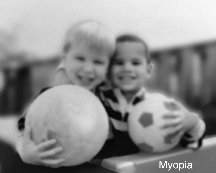Undernutrition
Several studies have investigated the relationship between body stature as an index of nutritional status and myopia. While the findings are conflicting, by far the largest study reviewed the data of over 100,000 consecutive male military recruits aged 17 to 19 years. It found that persons with severe myopia were slightly shorter and weighed less than those with mild myopia, while the non-myopes were taller and heavier than the myopes. Similarly, the mean body-mass index among the myopes was slightly smaller than among the non-myopes. (1)
In contrast to studies of people who had already become myopic, one small study compared 24 7-year-old children who subsequently developed myopia by the age of 10 to 68 children who were not myopic at the age of 10. The children who were to develop myopia had a generally lower intake of many food components, including total calories, protein and fat as well as several micronutrients. However, there were no significant differences in height and weight between the two groups at age 7 years, (2) suggesting that, unless they required less nutrients than normal children, the deficiencies were too subtle to affect growth.
Animal Protein
Compared with normally sighted children, myopic children were found to refuse animal protein (from fish, milk, cheese and eggs) more often - although they did eat meat. Moreover, myopia in children who refused to eat animal protein from those sources was found to be both more common and more severe. While 5% of normal children refused two protein sources, 7% of stationary myopes and 11% of active myopes did so. The most striking difference between the two groups was in milk consumption, with over three times as many advancing myopes refusing milk as compared to stationary myopes (16% vs. 5%). (3)
In a controlled clinical trial, 91 myopic school children were placed on a diet in which 10% of caloric intake was animal protein without any change in total calories. Calcium caseinate was used as a supplement for the 72 children who refused animal protein as ordinary food due to taste or lack of appetite.
After one to two years, compared to untreated controls, treated children showed a substantially lower average annual increase in myopia. In the younger children, the deterioration was greater in the controls by an average of 0.5 diopter each year while, in the older children, the progress of myopia was all but arrested in the treated group. The more severe the myopia at the start of treatment, the bigger the difference between treated and untreated groups. In general, the treated group deteriorated at about one-third the rate of the untreated group.
After six months, for the 16 children who consumed the amount of calcium caseinate advised, the mean change in refraction was an improvement of 0.02 diopters; in the 42 who took "some" calcium caseinate, the mean change was a deterioration of 0.16 diopters; and in the 14 who refused any calcium caseinate, there was a deterioration of 0.22 diopters. (4)
Dietary Fiber
There is preliminary data suggesting a relationship between the intake of dietary fiber and myopia. In a retrospective study of 120 binocular non-strabismic optometric patients aged 7 to 38 years, dietary fiber intake was significantly related to refractive strata, with myopes consuming an average of only 39% as much fiber in grams as hyperopes (farsighted people) (5.3 g vs. 13.55g).
The author suggests that this finding may be because hyperopes with higher fiber intake were eating more unrefined foods with better trace mineral availability, that the higher fiber intakes may result in more thorough mixing with saliva resulting in improved nutrient absorption, or because dietary fiber is often correlated with dietary folate, and the intake of dietary folate is highly correlated with myopia prevention/reversal. (5)
Refined Carbohydrates
Consistent with the hypothesis that a high intake of dietary fiber may be protective, there is evidence that a high intake of refined carbohydrates may promote myopia. When rats received a high sucrose diet upon weaning, the normal hypermetropia was significantly reduced (that is, a relative myopia developed) compared to controls. Then, when the sucrose and control group were reversed, myopia developed in the rats that were now receiving the high-sucrose diet. This myopia failed to reverse, however, when they were switched to a sucrose-free diet. (6)
There is also preliminary data in humans suggesting that the consumption of refined carbohydrates may be associated with the development of myopia. When the diets of optometric patients between the ages of 7 and 38 years were studied, myopes were found to have a significantly higher ratio of consumption of refined carbohydrates to total carbohydrates than hyperopes. Moreover, hyperopes had a lower ratio of consumption of refined to total carbohydrates than emmetropes (people who are neither nearsighted nor farsighted). (5)
In summary, inadequate childhood nutrition - especially in regard to animal protein and dietary fiber - appears to be a risk factor for the development of myopia.
References
(1.) Rosner M et al. Myopia and stature: findings in a population of 106,926 males. Eur J Ophthalmal 5(1):1-6, 1995
(2.) Edwards MH. Do variations in normal nutrition play a role in the development of myopia? Optom Vis Sci 73(10):638-43, 1996
(3.) Gardiner PA. Observations an the food habits of myopic children. Br Med J ii:699-700, 1956
(4.) Gardiner PA. Dietary treatment of myopia in children. Lancet i:1152-5, 1958
(5.) Lane BC. Myopia prevention and reversal: new data confirms the interaction of accommodative stress and deficit-inducing nutrition. J Int Acad Prev Med November, 1982:17-30
(6.) Bardiger M, Stock AL. The effects of sucrose-containing diets low in protein on ocular refraction in the rat. Proc Nutr Soc 31(1):4A-5A, 1972
Modified from Werbach MR with Moss J. Textbook of Nutritional Medicine. Tarzana, California, Third Line Press, Inc., 1999.
In his latest book, Dr. Werbach has assembled a unique library of case reports concerning nutritional and herbal treatments for 155 different illnesses. It is available in print or on diskette from Third Line Press Inc., 4751 Viviana Drive, Tarzana. California 91356, USA. (Phone: 818-996-0076; Fax: 818-774-1575; internet: http://www.third-line.com; e-mail: tlp@third-line.com).
COPYRIGHT 2003 The Townsend Letter Group
COPYRIGHT 2003 Gale Group



